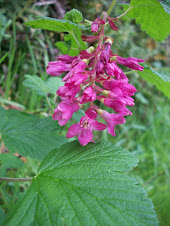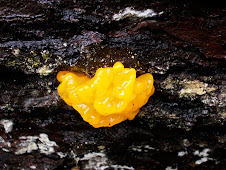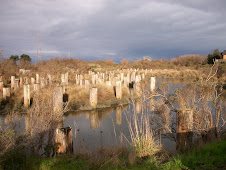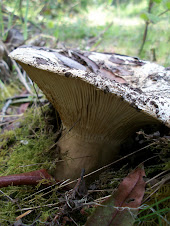On my return to Zion I decided to try a different hike. This time I stayed at a ranch above the park, the Zion Ranch Resort, where I was able to tent camp for $11/night. This meant my journey to my morning hike started with a sunrise driving descent down the Zion-Mount Carmel Highway, which winds through the park to the visitor center. I drove through several tunnels, including one which was over a mile long, which is a claustrophobic experience that is at once humbling and a bit troubling, but all-together wonderful! I was surprised as I passed by several cutouts in the rock- carved windows. It took all I had to not stop to peer through them. You can't stop in the tunnel, as traffic is difficult as it is. The road was created in the 1920s- I can't imagine the crazy blasting and labor that went into the creation of the road. On my descent down the grade the next day I saw a Desert Bighorn Sheep as I waited in the line for the exceedingly long and awesome tunnel.
This is one of my favorite drives ever. Every time I drove it the canyon looked different, under different weather and light conditions. With a rather large, stupid grin perma-stuck to my face, I drove like the tourist that I was, stopping at many of the turnouts to get out and take a million photos of the same landscape because there was no way I could encapsulate such beauty in any one photo. Finally I arrived at the visitor center. As I got out, exchanged my flip flops for my hiking boots and threw the ingredients for pb and j sandwiches in my Camelback, I spotted movement across the street. Some photographers had gathered to take pictures of a deer and two fawns grazing in front of the towering red rock landscape. I thought to myself "This place is frickin' magical!" I hadn't even made it to the shuttle and I was in love all over again.
I took the bus to The Grotto (no cars allowed on the main drive, by the way, unless you stay at the Zion Lodge). This stop is the jumping-off point for several hikes, including the West Rim Trail to Angel's Landing. On the bus ride up I became slightly concerned about taking this hike, considering the narrative being played over the loudspeaker, which strongly encouraged hikers to skip this hike if they are afraid of heights or are beginning hikers. The description in the guide distributed by the park states "Long drop-offs. Not for young children or anyone fearful of heights. Last section is a route along a steep, narrow ridge to the summit." I heard stories of many who turned back or waited for braver members of their party at a specific tree, where the trail narrowed and the chain trail began. They called the tree "The Widowmaker."

Still, I departed the bus with a great sense of excitement to start the steep ascent of the 5.4 mile hike. To get to the trail head you pass over a metal and wooden bridge over the Virgin River, with majestic rockscapes on all side of you and cottonwoods waving brightly in the breeze. The beginning of the trail made me feel a cow in a herd of cattle, winding in single-file with my fellow-hikers, slowly up the ever-increasingly-steep switchbacks to the top. I stopped to allow a tarantula to cross the path, pointing him out to the hikers behind me, with mixed reactions from the crowd. Many people are terrified of them, as if they think the tarantula will jump on them. I find them to be quite peaceful creatures though and have held them on several occasions.
After what seemed like a long schlep of panting and hiking ever-upward, the path cut through a canyon between two mountains. It felt cooler here as I entered an unusual riparian habitat. It was a nice change as the day was growing hotter and I was regretting my choice of jeans, rather than light hiking pants. The wall of rock to my right held odd formations that must have been formed from previous floods, with odd pockets and holes you could almost climb into. Then I got to a section of the hiker which I later learned was named "Walter's Wiggle," named after their creator, the park's 1st superintendent. They are tighter than the previous switchbacks and are paved in asphalt. There are 21 of them, leading to a plateau that I foolishly thought for a moment was the top. Oh no- we were just getting started.
I stopped for a moment to consider the compostable toilets present on this plateau- how did they get those things up here? I took a moment to consider the work that has been put into this hike over the years by trail crews- incredible. Then I took in the hike ahead of me-a single-file rock climbing adventure along the very narrow peak to the top. There is quite the procession of people ascending and descending, pausing to allow safe passage. I also noticed that here began the silver chain that was fated to become my instant friend. This is what you clung to in hairy points of the hike, where I thought I might fall some 1400 feet to my death. Nothing but air on either side of you, and no room for error. I considered stopping for a second, but quickly told myself I would make it to the top because I had made it this far and I am not one to turn back. I knew I would regret it forever if I didn't finish the hike.
I made it to the top, along with about 20 others. It was a bit of a party atmosphere at the top. People took selfies, ate lunch and even played music on speakers they brought along. The feeling began to dawn on me as I at my pb&j that the journey was, in fact, only halfway over. I still had the descent- and what a knee-shaking one it was! By the time I got back to the bottom of the trail and crossed the bridge my legs were protesting loudly. But I had done it! The hike to Angel's Landing had turned out to be one of my favorites of all the hikes I had experienced!















